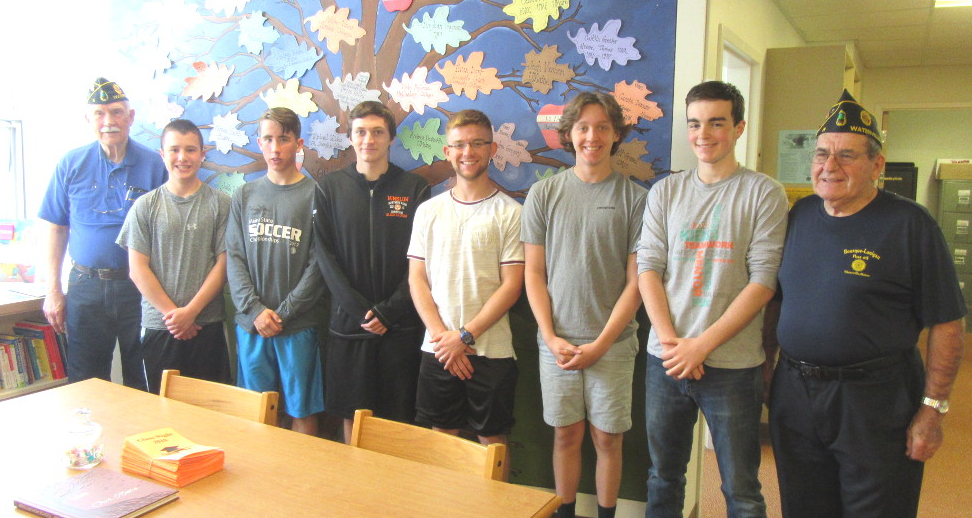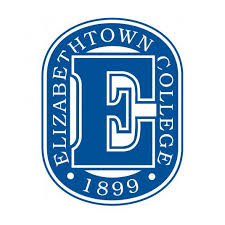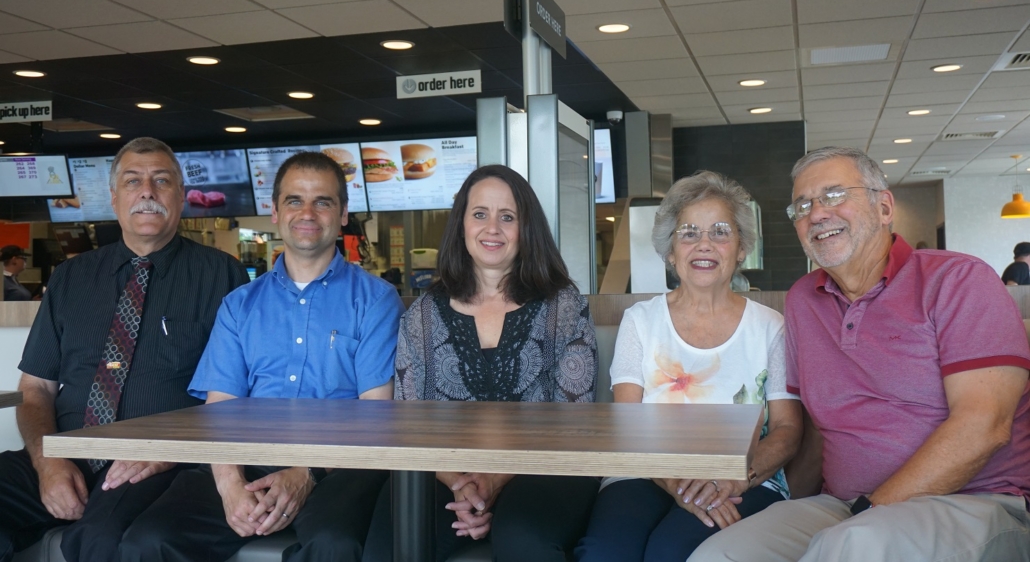Andreozzi and Veilleux on dean’s list at Dean College
 Dean College, in Franklin, Massachusetts, has announced that Kiara Andreozzi, of Waterville, and Joshua Veilleux, of Winslow, have earned a place on the dean’s list for the Spring 2018 semester.
Dean College, in Franklin, Massachusetts, has announced that Kiara Andreozzi, of Waterville, and Joshua Veilleux, of Winslow, have earned a place on the dean’s list for the Spring 2018 semester.

 Dean College, in Franklin, Massachusetts, has announced that Kiara Andreozzi, of Waterville, and Joshua Veilleux, of Winslow, have earned a place on the dean’s list for the Spring 2018 semester.
Dean College, in Franklin, Massachusetts, has announced that Kiara Andreozzi, of Waterville, and Joshua Veilleux, of Winslow, have earned a place on the dean’s list for the Spring 2018 semester.

Hannah Comfort of Winslow (Russ Dillingham/Sun Journal)
June 28 marks the start of competition for Hannah Comfort, the Winslow teen competing in the 61st Distinguished Young Women National Finals. Comfort, along with 49 other state representatives, has been in Mobile for the past two weeks.
The program’s evaluation process includes scholastics, interview, fitness, talent and self-expression. Comfort has completed an individual interview with a panel of five judges and her scholastic performance has been scored through an evaluation process of her high school academic record and standardized test scores.
For her talent presentation, Comfort will perform a tap and vocal piece titled “I Can Do That.” Comfort is a 2018 graduate of Waterville Senior High School and the daughter of Michele Lacombe.

In photo, from left to right, American Legion Post # 5, in Waterville, Legionnaire Larry Mitchell, students Josh Gordon, Nick Tiner, Isaac Lambrecht, Jake Witham, Zack Laflamme, Jared Goss, and Legionnaire Pearley Lachance. (Contributed photo)
Seven Juniors from Winslow High School will be attending the 71st annual American Legion Dirigo Boys State Program, at Thomas College, in Waterville, during the week of June 17-21, 2018. The students will participate in activities that will show them how local, county and state government works.
Ye Female Society for the Support of the Gospel invites all women of all ages, to join them for their 200th annual meeting on Tuesday, June 19, at 2 p.m., at Winslow Congregational Church, UCC, at 12 Lithgow St., Winslow.
The first meeting of this organization was in June of 1819 to raise money for the allocation of a pastor, a legal requirement for every town with a church. Ladies of Winslow and Clinton met and gave 25 cents each to pay for a pastor. Since then, every third Tuesday of June ladies gather in the church hall and follow the historic order of agenda, which includes reading the organization’s constitution written in 1819, and paying their 25 cent dues. Over the years a program was added to the meeting. Past programs have included gardeners, artists, historians, performances of music and theater, reenactors, and leaders of local non-profits.
This year the group celebrates its 200th annual meeting with much pomp and circumstance. President Emily Rowden Fournier, of Fairfield, will welcome women of all denominations to the meeting. Pastor Kim Shrader, the reverend of Winslow Congregational Church, will offer inspirational scripture reading and prayer. Special ceremonies will be conducted in honor of the founding mothers and to remember many women of the society who have been the primary “movers and shakers” of Winslow, putting this notable group at the center of many improvements throughout Winslow’s history. Local historian, Pearley Lachance, of Winslow, will present a program on Gold Star Mothers of World War I. A presentation of old photos and the society scrapbook will be displayed.
This is an historic event for what is believed to be the longest continuously meeting female society in America. All members and interested women are urged to attend and bring memorabilia of interest to the society. Period clothing from the past 200 years may be worn. Refreshments will be served.
For more information, please call Emily Rowden Fournier at 207-314-8607.
 Jessica Crouse, of Winslow, was named to the dean’s list of Elizabethtown College, in Elizabethtown, Pennsylvania, for the spring 2018 semester. Crouse is a class of 2018 Environmental Science major.
Jessica Crouse, of Winslow, was named to the dean’s list of Elizabethtown College, in Elizabethtown, Pennsylvania, for the spring 2018 semester. Crouse is a class of 2018 Environmental Science major.
Students on the dean’s list are full-time undergraduate students who earn a semester grade point average of 3.60 or better in 14 or more credit hours, of which at least 12 credits are letter-graded course work

Winslow McDonald’s first general manager, Jim Sevey, left, sits in the new dining room with two generations of Ortins, from left to right, Mike and Lana, and Lorraine and Bob. Photo by Eric Austin
It’s hard to find anything more American than McDonald’s, or more emblematic of the American spirit than the family business. The recent remodel of the McDonald’s, in Winslow, represents both these traditions and it’s a story more than 30 years in the making.
In 1986, Bob Ortins moved his family to central Maine. After years working for the McDonald’s corporation, starting in 1971, an opportunity had opened up to buy four McDonald’s restaurants in the Pine Tree State. The move proved to be a huge success, and at their peak, the Ortins family owned nine restaurants across central Maine.
Around this same time, another small business was also starting to make a local name for itself. Although founded in 1974 by David Poulin, of Brunswick, Poulin Construction earned state-wide fame in 1984 for their classy conversion of the historic Gore House into a McDonald’s restaurant, in Freeport. This early success led to an on-going relationship with the McDonald’s corporation and eventually to a partnership with Bob Ortins, who, in the fall of 1987, hired Poulin Construction to build a new McDonald’s restaurant on the China Road, in Winslow.
In 2014, Brent Poulin bought the construction business from his father. And Bob Ortins’ son Mike, after working with his father for more than 30 years in every conceivable position, from cashier to general manager, took over full control of the business with his wife, Lana, in 2016.
Now, more than 30 years after that first building project, these two families have come back together for a renovation of the original restaurant as part of McDonald’s “Experience of the Future” initiative.
“It’s about building a better McDonald’s,” Mike tells me as we sit outside in the shade, watching workers from Poulin Construction put the finishing touches on the remodel.
The renovations will feature a number of cool new updates and modern conveniences. Along with a sleeker, more contemporary look to the interior, the location will now showcase high-definition, digital menu boards inside and out. The remodeled restaurant will also feature two self-service kiosks – enabling customers to order from a touchscreen menu without standing in line – and table-location technology, allowing employees to deliver food directly to a customer’s table.
McDonald’s has also recently implemented a new “always fresh, never frozen” policy for all their quarter-pound burgers, which owner Mike Ortins says makes them taste “even better than before.”
Another feature, which has been available for some time, is the ability to make one’s order via McDonald’s new mobile app. However, the renovations will add to this convenience by designating two parking spots on the east side of the restaurant specifically for “curbside ordering.” Park here, submit your order via the mobile app, and a few minutes later your food will be brought directly to the car!
The Ortins have succeeded because of a deep commitment to their employees and the communities in which they live. Offering tuition assistance of up to $3,000 a year, many employees start working part-time as they go to school. Jim Sevey, the first general manager of the McDonald’s location in Winslow when it was opened in 1987, is now a company supervisor and will be on hand at the ribbon-cutting ceremony on June 16.
Mike Ortins firmly believes in supporting the local community and has sponsored a number of fundraisers over the years, such as McPuzzle Night in support of autism awareness. He plans to continue that tradition. At the grand re-opening of the Winslow’s McDonald’s on Saturday, June 16, 20 percent of all purchases between 9 a.m. to 1 p.m. will be donated, along with a check for $1,000, to the Winslow Parks and Recreation Department.

Front, left to right, Madison Field, Logan Levesque, Elijah Ker, Mikayla Pooley, Emily Daigneault, Isabel Citro and Caden Pelotte. Back, Joshua True, Syrus Washburn, Coltrane McRae, Madisyn Hines, Jackson Hineman and Moses McRae (Photo by Mark Huard)
Young students from Huard’s Martial Arts, in Winslow, earned new green and brown belt ranks on May 25.

David LaFountain, retiring chief of both Waterville and Winslow fire departments (left), Andrew Clark, chief of Albion Fire and Rescue (right), and Senator Scott Cyrway (center). (Contributed photo)
David LaFountain, retiring chief of both Waterville and Winslow fire departments, and Andrew Clark, chief of Albion Fire and Rescue, were both recipients of EMS Excellence Awards at a ceremony put on by Maine Emergency Medical Services, in Augusta, on May 23. EMS Excellence Awards recognize individuals for their contributions to the EMS system, either in their area or to the state as a whole. Senator Scott Cyrway (R-Kennebec) attended the awards ceremony, presenting both recipients with legislative sentiments recognizing their accomplishments. Timothy Beals, of Waterville, executive director of Delta Ambulance, was also an EMS Excellence Award recipient, but he was unable to attend the ceremony.
 Dean College, in Franklin, Massachusetts, has named the students that have earned a place on the dean’s list for the Fall 2017 semester.
Dean College, in Franklin, Massachusetts, has named the students that have earned a place on the dean’s list for the Fall 2017 semester.
Cami Dubois, of Winslow; Madison Grass, of Vassalboro; and Joshua Veilleux, of Winslow.
